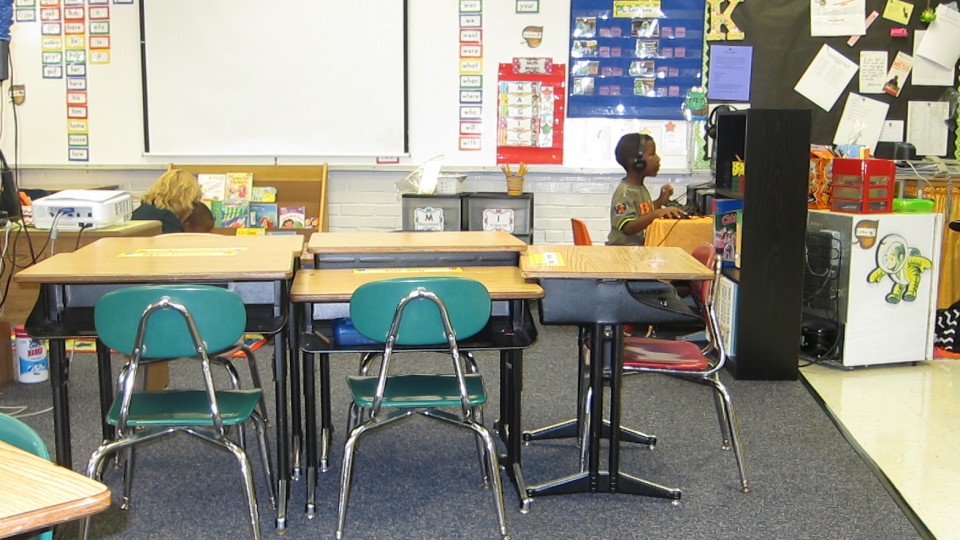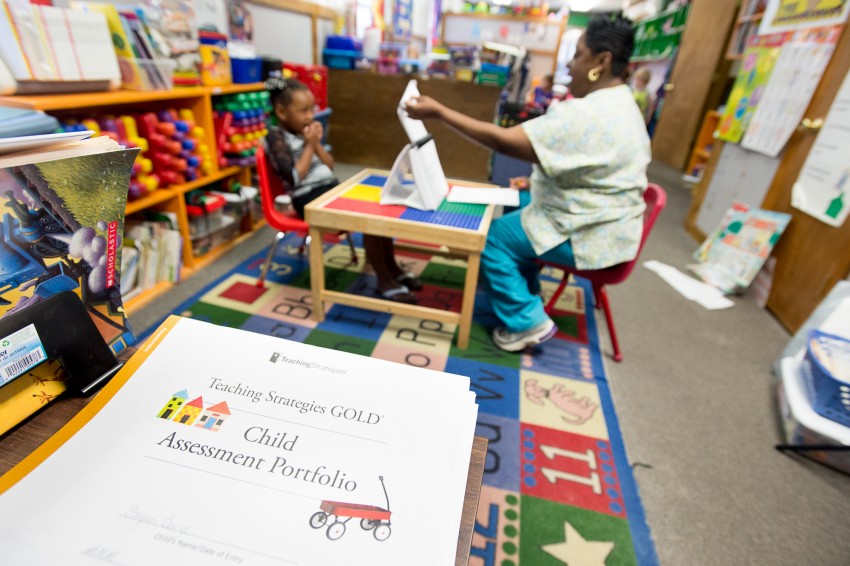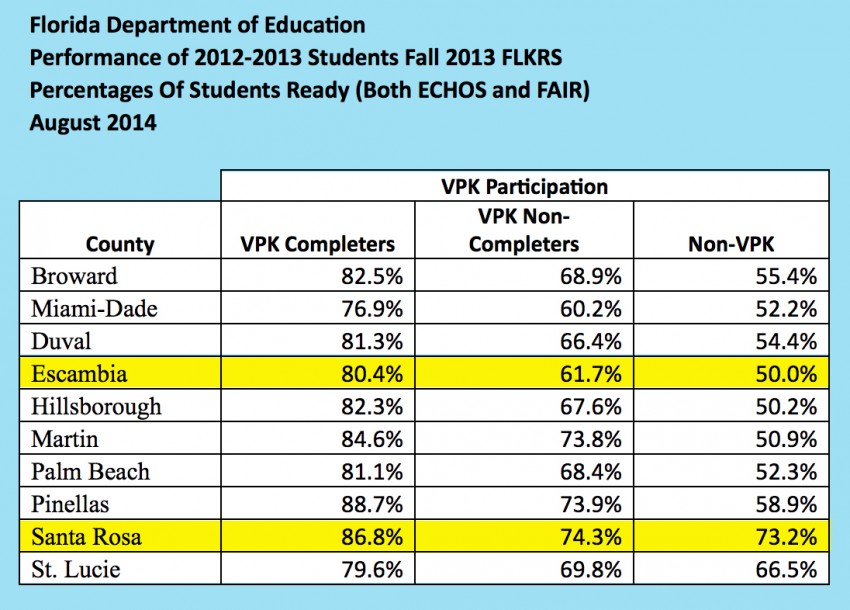Helping 5-year-olds make the grade
- January 11, 2016
- / Shannon Nickinson
- / education

Access to a strong preschool experience can boost a student's kindergarten readiness. Photo credit: Shannon Nickinson
This year, there are 2,959 kindergarteners in Escambia County Schools this year.
About 1,000 of them were not ready for school, based on the most recently available kindergarten readiness data.
That’s the challenge when it comes to kindergarten readiness, one of 16 metrics in the Studer Community Institute’s Pensacola Metro Dashboard, which measures the economic, educational and social well-being of the community.
In the 2013-2014 school year, Escambia County 66 percent of 5-year-olds were ready for school, according to data analysis from the Florida Office of Early Learning.
Changes to the way the state will determine kindergarten readiness are under way, but they mean that there won’t be new readiness data until 2017.
This week providers received preliminary readiness data from the Office of Early Learning about children who were in their programs.
Cynthia Sucher, spokeswoman for the office, said sometime later this spring, those findings will be available to the public once the state Board of Education approves an administrative rule allowing their release.
Once public school kindergarten teachers evaluated kindergarteners using two tests in the first 30 days of school that gauged both a child’s academic skills and his or her social and emotional development.
Now readiness will be gauged by voluntary prekindergarten teachers who teach the children as 4-year-olds. Providers are piloting the tool, Teaching Strategies Gold, this year; it will go into full effect in the 2016-2017 school year.

Pre-K teacher Shemetri Charley does an assessment with Ca’Miyah Robinson at Wee Kare Academy Friday, Sept. 11, 2015. (Michael Spooneybarger/ Studer Community Institute)
“Since VPK has begun, every couple of years there’s been a change in how assessments were done,” says Tara Huls, who leads VPK program and policy in the Office of Early Learning. “This isn’t the first time we’ve had such a change. Teaching Strategies Gold is not being used in readiness (yet) because the statute requires two years worth of data to look at learning gains. That’s a few legislative sessions away.”
Participation in VPK does improve a child’s kindergarten readiness, according to data from the Office of Early Learning.

Kindergarten readiness data from eight counties that have Children's Services Councils, as well as data for Escambia and Santa Rosa counties.
The Escambia County Early Learning Coalition manages the funding for the state VPK program. Bruce Watson, the coalition’s executive director, says VPK enrollment dropped off from 2,544 last year to 2,080 for this school year.
According to Census data, in 2015 there were 3,589 4-year-olds in Escambia County.
That means there were about 1,000 children eligible for VPK who weren’t enrolled.
Watson believes the drop off in VPK enrollment reflects two things:
— Until this year, the number one reason parents do not send their child to VPK is lack of transportation coupled with a three-hour school day.
“It makes it hard to justify the effort to get the child there and back, especially when the parent is working regular hours,” he says.
— This year, the state instituted a new mandatory online registration system. All VPK registration had to be made using their online system.
“Although we went out of way to assist the parents, I think many decided registration was too hard,” he says.
There are nearly 8,200 children under the age of 5 in Census tracts in Escambia County where the poverty rate for families with children is 10 percent or higher.
There are just 3,000 children under 5 years old in neighborhoods where the poverty rate for families is 5 percent or less.
What teachers are looking for in readiness
Providers will use the Teaching Strategies Gold system to evaluate each of their children three times a year on a laundry list of skills.
It is meant to reflect the Common Core-focused standards that Florida public schools have in place.
Florida has had VPK since 2005, and has seen several changes in that time.
— New bureaucracy. The Office of Early Learning used to be its own entity. It was put under the Florida Department of Education in 2013. And while the public school system takes responsibility for these children once they enter kindergarten, many VPKs are run by private or faith-based entities and are not supervised by the K-12 school system.
— Revised rating system. In 2010, Florida revised its preschool rating system. A successful VPK is one where 70 percent or higher of students receive a passing score on their kindergarten readiness test. If the scores drop below 70 percent, the VPK is deemed nonperforming.
Underperforming providers are on probation for up to three years and have to submit improvement plans. If after three years providers don’t improve, they must shut down their VPK program and apply again to be readmitted to the program.
— Declining state funding. Bruce Watson of the Early Learning Coalition, notes that the state cut $9 million out of the overall VPK budget last year. Watson’s budget for VPK is about $5,420,650 — $2,360 per child.
But state funding has declined every year since 2007, he says.
“Our lawmakers are failing to understand the impact of their decisions, when we’re paying (providers) less today than we did eight years ago and expect the same results,” Watson said earlier this year.
— Problems with readiness test. Last year the state announced that the test to assess kindergarten readiness wouldn’t be given because of technology problems that overwhelmed the system.
It includes math and language arts milestones (counting with blocks, recognizing numbers and letters, sight word development), as well as social and emotional development milestones.
“Right now,: Huls says, “VPK pre- and post assessments both are administered by the program themselves, and we still have screening being done in kindergarten teachers in public school. Going into place now is an assessment by provider and then a separate look provided by the kindergarten teacher, but all of this is still unfolding.”
Huls says the state has looked at literacy and math but not the developmental markers. The Teaching Strategies Gold tool should offer an opportunity to look at both when gauging readiness, she says.
This year, providers will do one evaluation in the spring. For the 2016-2017 school year, they will test kids three times — at the beginning, middle and end of the school year.
Among the skills and behaviors Teaching Strategies looks for:
— That a child can manage her feelings, follow rules, interacts with friends, responds to emotional cues and makes friends.
— That a child can hold and use a pencil or crayon the right way, can balance on one foot.
— That a child can follow directions, speaks clearly, has an expressive vocabulary, can tell about another time or place.
— That a child shows curiosity, looks for ways to solve problems, connects new knowledge to things he already knows, engages in dramatic play.
— That a child appreciates and knows how to use books, knows letters on sight and the sounds they make, notice rhyme and alliteration, writes her name, retells stories he’s heard.
— That a child counts and connects the numerals with the quantities they represent, understands shapes and spatial relationships, compares and measures.
— That a child uses tools and technology to perform tasks, shows knowledge of living things and their traits.
— That a child shows knowledge of herself, other people and how they live.
— That a child explores visual arts, music, dance and drama through actions and language.
 CivicCon launches with a look at good growth in cities
CivicCon launches with a look at good growth in cities
 Building stronger brains one baby, one parent at a time
Building stronger brains one baby, one parent at a time
 SCI debuts commercial on Early Learning City
SCI debuts commercial on Early Learning City
 Entrecon: World class speakers and an opportunity to sharpen skills
Entrecon: World class speakers and an opportunity to sharpen skills
 PYP Quality of Life survey 2017
PYP Quality of Life survey 2017
 EntreCon Pensacola 2016: A look back
EntreCon Pensacola 2016: A look back
 Leadership tip: getting better employee takeaways
Leadership tip: getting better employee takeaways
 Leadership tip: be interested instead of interesting
Leadership tip: be interested instead of interesting
 Leadership tip: delivering difficult messages
Leadership tip: delivering difficult messages
 Brain Bags boost Arc, Early Childhood Court programs
Brain Bags boost Arc, Early Childhood Court programs